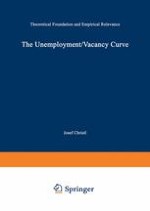1992 | OriginalPaper | Chapter
The Concept of the Beveridge Curve
Author : Univ. Doz. Dr. Josef Christl
Published in: The Unemployment/Vacancy Curve
Publisher: Physica-Verlag HD
Included in: Professional Book Archive
Activate our intelligent search to find suitable subject content or patents.
Select sections of text to find matching patents with Artificial Intelligence. powered by
Select sections of text to find additional relevant content using AI-assisted search. powered by
The basic idea of the U/V curve, which was initially defined as a negatively sloped relation between unemployment and vacancies
1)
, can be found in the paper of Dow/Dicks-Mireaux (1958) “The Excess Demand for Labour”. In their study, which is primarily concerned with the question whether unemployment and unfilled vacancies are good indicators for trends in the demand for labour, they state (p. 3f):
“We must now consider more closely how changes in the pressure of demand can be expected to affect the statistics of unemployment and of vacancies. It is convenient to abstract from two other things which we have already seen may affect the figures, namely changes in the degree of over- or under-statement of vacancies and changes in labour maladjustment. An increase in the pressure of demand will then always increase the level of unfilled vacancies reported, and reduce unemployment. But even at very high levels of demand there would remain some unemployment, i.e. above a certain point unemployment is decreasingly sensitive to demand. The reverse is true of the statistics of unfilled vacancies. Even when demand was clearly deficient, some unfilled vacancies would remain, so that
below
a certain point the level of vacancies must be reckoned as decreasingly sensitive to demand.”
